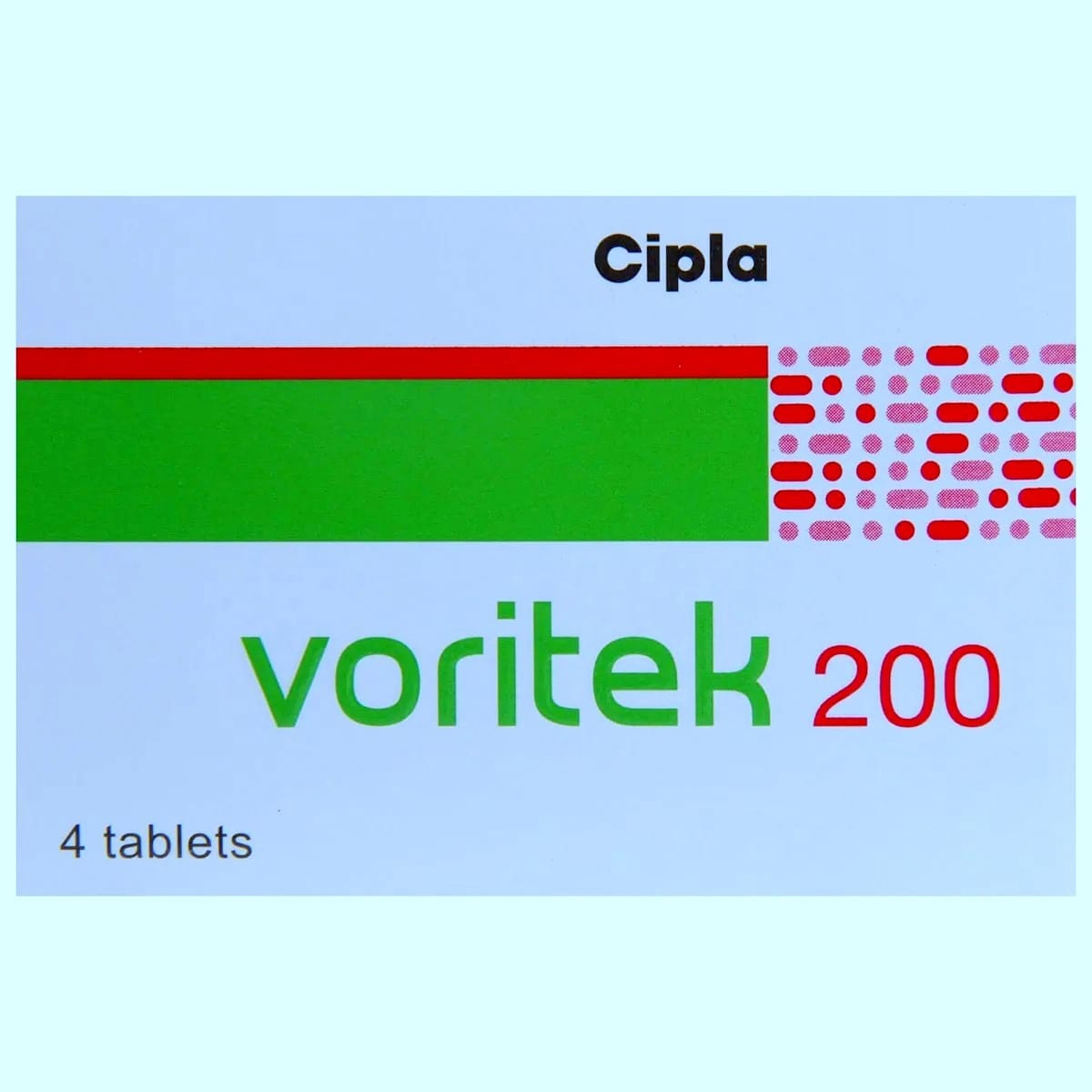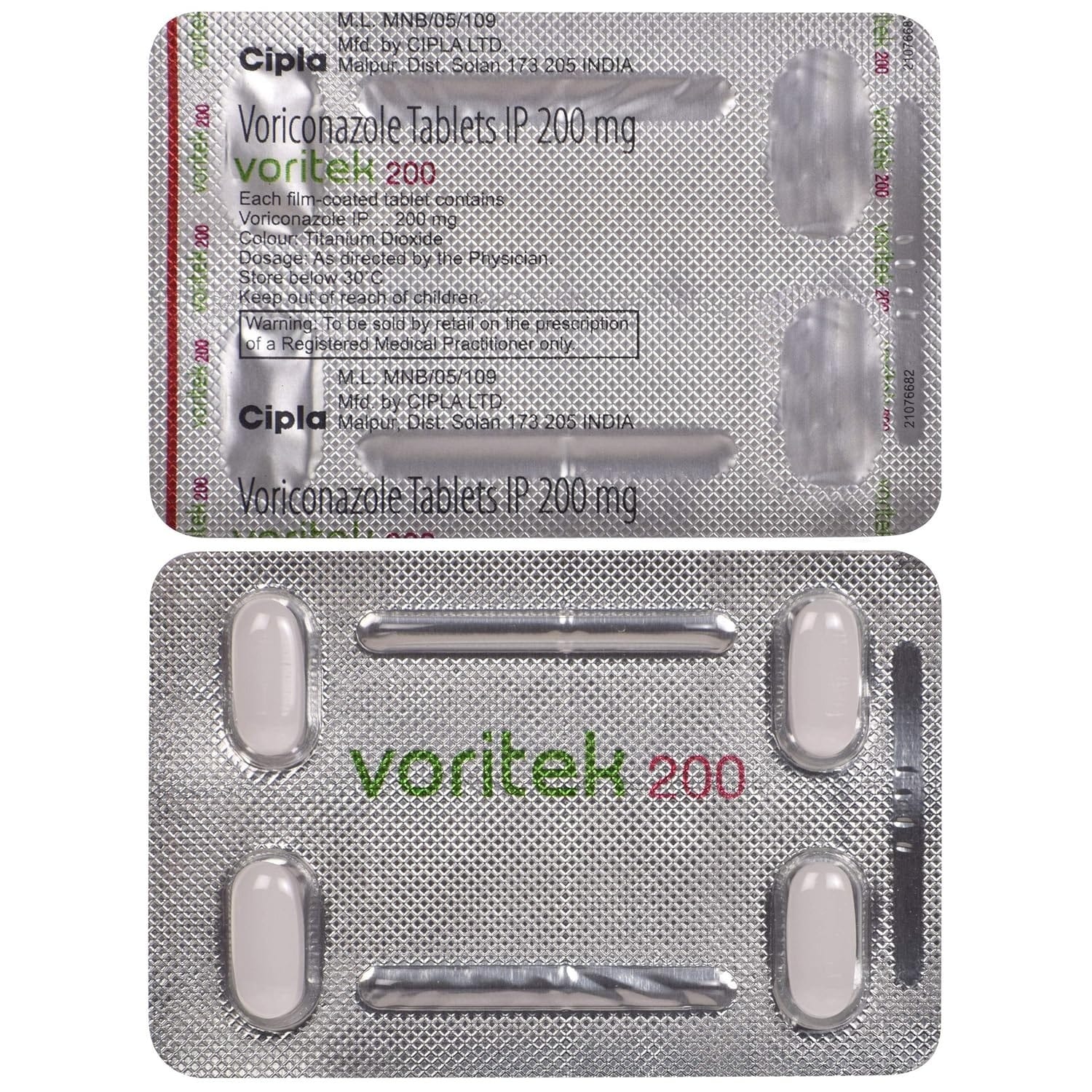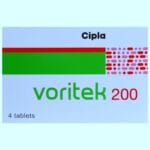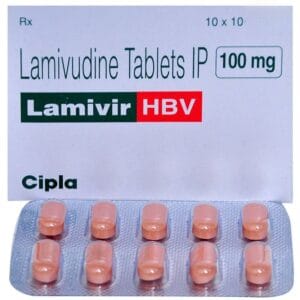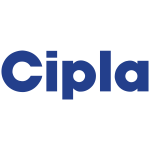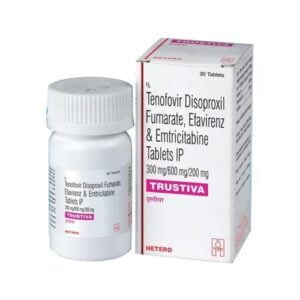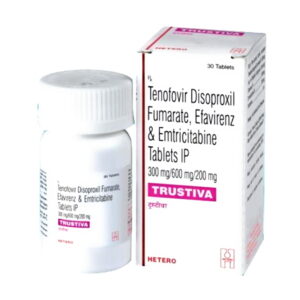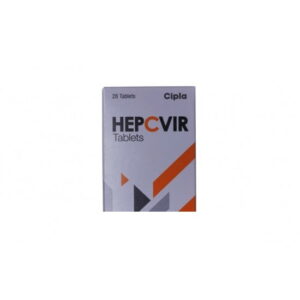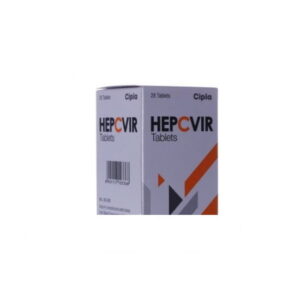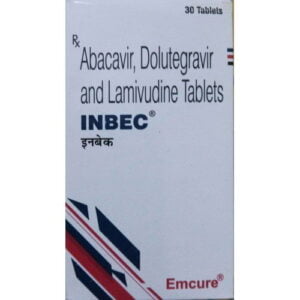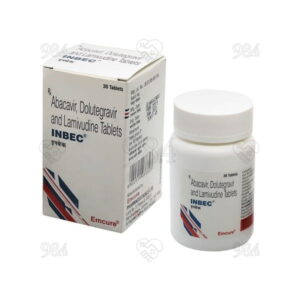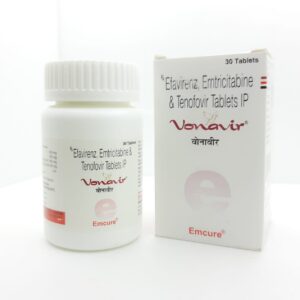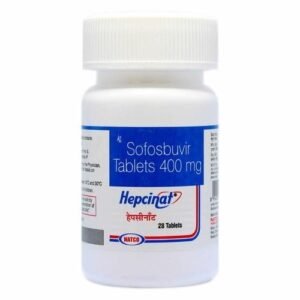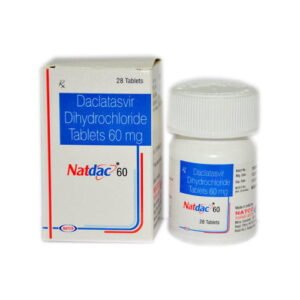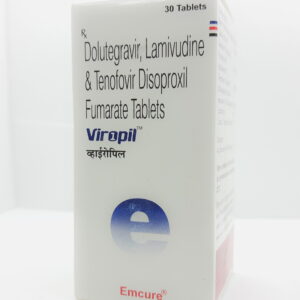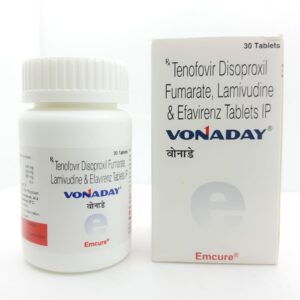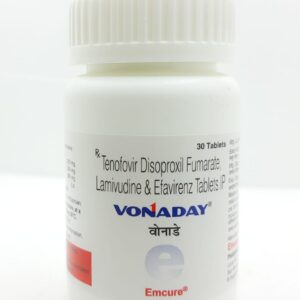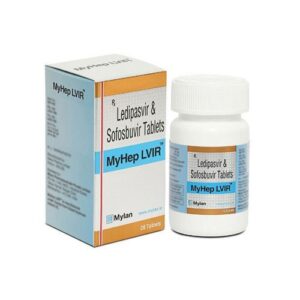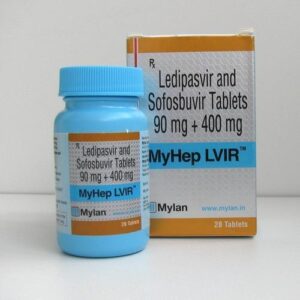Last Updated on April 9, 2025 by admin
Voritek 200 mg Tablet – Detailed Introduction
Voritek 200 mg tablet is a potent, broad-spectrum, second-generation triazole antifungal agent primarily indicated for the treatment of serious and potentially life-threatening fungal infections caused by susceptible organisms, particularly in immunocompromised individuals or those with underlying conditions that predispose them to invasive mycoses. The active ingredient, Voritek 200, functions by inhibiting the fungal cytochrome P450 enzyme 14α-sterol demethylase, a crucial enzyme in the ergosterol biosynthesis pathway, thereby disrupting cell membrane formation and function in fungal organisms, ultimately leading to fungal cell death. The medication exhibits excellent activity against a wide variety of pathogenic fungi, including Aspergillus species (notably effective in treating invasive aspergillosis), Candida species (including fluconazole-resistant strains), Scedosporium apiospermum, and Fusarium species, making it a critical option in the armamentarium against resistant and emerging fungal infections. Voritek 200 is often used when other antifungals such as amphotericin B or fluconazole prove ineffective or are contraindicated due to toxicity or resistance patterns. Each tablet contains 200 mg of Voritek 200 and is typically prescribed as part of a loading and maintenance regimen: an initial oral loading dose of 400 mg every 12 hours for the first 24 hours, followed by a maintenance dose of 200 mg every 12 hours, although the dosing may vary depending on patient factors including body weight, renal and hepatic function, the site and severity of infection, and concomitant medications. The oral formulation has high bioavailability (approximately 96%), allowing for effective systemic levels without the need for intravenous administration in many cases, and it achieves therapeutic concentrations in various tissues including the lungs, liver, kidneys, and central nervous system, which is particularly useful for treating disseminated or deep-seated infections. Voritek 200 undergoes extensive hepatic metabolism primarily via CYP2C19, with additional involvement of CYP2C9 and CYP3A4 isoenzymes, and the presence of significant interindividual variability in metabolism—especially in populations with poor metabolizer phenotypes—necessitates close monitoring and possible therapeutic drug monitoring (TDM) to optimize efficacy and minimize toxicity. The drug’s safety profile is characterized by several dose-related and time-dependent adverse effects; the most common among these include transient visual disturbances such as blurred vision, photophobia, and altered color perception (often occurring shortly after dosing and resolving without intervention), hepatic enzyme elevation (requiring regular liver function monitoring), rash, gastrointestinal disturbances such as nausea, vomiting, abdominal pain, and diarrhea, as well as more serious effects such as QT interval prolongation, hallucinations, photosensitivity reactions that may lead to phototoxicity and skin cancers with prolonged use, and rare but serious hepatotoxicity. Voritek 200 is contraindicated in patients with known hypersensitivity to the drug or its components and must be used with extreme caution in those with preexisting liver disease; dose adjustments are often required in hepatic impairment, especially when used chronically. Due to its strong interaction profile, Voritek 200 must be carefully prescribed with attention to potential drug-drug interactions, as it both inhibits and is metabolized by several cytochrome P450 enzymes, meaning coadministration with drugs such as rifampin, carbamazepine, phenobarbital, certain statins, ergot alkaloids, and sirolimus is contraindicated or requires strict monitoring and adjustments. Similarly, therapeutic levels can be impacted by the use of proton pump inhibitors, oral contraceptives, anticoagulants, and antiretroviral agents, necessitating clinical vigilance. Voritek 200is not recommended for use during pregnancy unless the potential benefit clearly outweighs the risk, as it has shown teratogenic effects in animal studies; likewise, breastfeeding should be discontinued during therapy due to potential drug excretion in breast milk. Patients receiving Voritek 200 are advised to avoid direct exposure to sunlight or UV light due to an increased risk of phototoxicity, and the use of broad-spectrum sunscreen and protective clothing is strongly recommended during and following treatment. Voritek 200 therapy is typically initiated under specialist supervision, especially in the context of hematologic malignancies, stem cell or solid organ transplantation, HIV/AIDS with opportunistic infections, or post-chemotherapy neutropenia, where the balance between immunosuppression and antifungal prophylaxis or treatment is particularly delicate. As part of a comprehensive antifungal stewardship approach, routine susceptibility testing, liver function tests, renal function assessments, therapeutic drug monitoring (especially if therapy exceeds 7 days or is combined with other hepatotoxic drugs), and clinical evaluation are important to ensure the success of Voritek 200 therapy and to prevent the emergence of resistance. Additionally, genetic polymorphism testing for CYP2C19 may be considered in certain populations to predict poor metabolizer status and guide individualized dosing. The tablet should be taken at least one hour before or one hour after meals to maximize absorption, and tablets should be swallowed whole with a glass of water. In clinical trials and real-world studies, Voritek 200 has demonstrated superiority over amphotericin B in terms of efficacy and tolerability for invasive aspergillosis and has become the first-line treatment in many international guidelines. Despite its efficacy, the cost of Voritek 200 and the need for careful monitoring can limit its accessibility in some regions, though its availability in both oral and IV formulations allows for flexible administration based on patient needs and institutional resources. In summary, Voritek 200 mg tablet represents a cornerstone in modern antifungal therapy, providing clinicians with a powerful tool for managing complex fungal infections, particularly in high-risk populations, and its use must be carefully balanced with appropriate clinical oversight to ensure optimal outcomes, minimize risks, and maintain antifungal stewardship principles in an era of rising antimicrobial resistance and evolving fungal epidemiology.
Uses of Voritek 200 Tablet
- Fungal infections
- Severe fungal infections
- Dandruff
Voritek is used to treat serious and potentially life-threatening fungal infections, particularly in immunocompromised individuals such as those undergoing chemotherapy, organ transplantation, or with HIV/AIDS.
✅ 1. Invasive Aspergillosis
A severe infection caused by Aspergillus species.
Common in people with weakened immune systems (e.g., after organ transplant, chemotherapy, or in chronic granulomatous disease).
Voritek 200 is considered the first-line treatment for this condition.
✅ 2. Candidemia
A bloodstream infection caused by Candida species.
Typically seen in hospitalized or critically ill patients (e.g., ICU patients, those with central venous catheters).
Voritek 200 is used when the infection is resistant to or not responding to first-line antifungals like fluconazole.
✅ 3. Esophageal Candidiasis
A fungal infection of the esophagus caused by Candida albicans and other Candida species.
Common in immunosuppressed individuals (e.g., HIV/AIDS patients).
Used when fluconazole is ineffective or contraindicated.
✅ 4. Scedosporium apiospermum Infections
A rare, serious fungal infection often affecting lungs, skin, or brain.
Voritek 200 is one of the few antifungals active against this pathogen.
✅ 5. Fusarium Infections
Infections caused by Fusarium species, which are highly resistant to many antifungals.
Can affect skin, eyes, and blood (especially in immunocompromised patients).
Voritek 200 is among the limited treatment options.
✅ 6. Empirical Antifungal Therapy in Febrile Neutropenic Patients
Used when a patient has persistent fever despite antibiotics, and there’s suspicion of a fungal infection.
Especially important in patients with very low white blood cell counts (neutropenia), such as those undergoing chemotherapy.
⚠️ Note: Voritek 200 is generally reserved for serious infections and is not used for simple fungal conditions like vaginal candidiasis, athlete’s foot, or mild oral thrush unless resistant or complicated.
⚠️ Side Effects of Voritek 200 mg Tablet
✅ Common Side Effects
These usually occur in many patients but are often mild and manageable:
Visual disturbances
Blurred vision
Changes in color perception
Photophobia (sensitivity to light)
Usually temporary and reversible
Fever
Nausea and vomiting
Diarrhea
Headache
Skin rash
Elevated liver enzymes (may be found on blood tests)
⚠️ Less Common Side Effects
These may affect some patients and might need medical attention:
Abdominal pain
Hallucinations or confusion
Swelling (edema) of face, hands, or legs
Fatigue or weakness
Increased sensitivity to sunlight (photosensitivity)
Insomnia or trouble sleeping
Changes in taste
❗ Serious and Rare Side Effects
These are potentially life-threatening or require immediate medical intervention:
Hepatotoxicity (Liver damage)
Symptoms: Yellowing of the skin or eyes (jaundice), dark urine, severe fatigue
Stevens-Johnson Syndrome (SJS)
A severe skin reaction with blistering and peeling
QT Prolongation / Arrhythmia
Can lead to dangerous irregular heartbeats
Severe allergic reaction (anaphylaxis)
Rash, swelling of face/throat, breathing difficulty
Pancreatitis
Inflammation of the pancreas, presenting as severe abdominal pain
Skin cancer (with long-term use)
Especially with long-term exposure to sunlight while on treatment
🩺 Monitoring
Due to the potential for serious side effects, patients on Voritek 200 often require:
Regular liver function tests
Kidney function tests
Electrolyte monitoring
Eye exams (if on long-term therapy)
Skin checks (especially for those on long-term treatment)
📝 Summary Table
| Category | Side Effects |
|---|---|
| Common | Visual changes, nausea, headache, rash, liver enzyme rise |
| Less Common | Hallucinations, insomnia, photosensitivity, taste change |
| Serious / Rare | Liver damage, SJS, heart rhythm issues, allergic reaction |
⚠️ Drug Warnings – Voritek 200 mg Tablet
Voritek 200 is a powerful antifungal and must be used with care. Below are key warnings that patients and healthcare providers should be aware of.
🧬 1. Liver Toxicity (Hepatotoxicity)
Warning: Voritek 200 can cause elevated liver enzymes and liver damage.
Monitor: Liver function tests (LFTs) should be done before and regularly during treatment.
Signs to watch for: Yellowing of the skin/eyes (jaundice), dark urine, abdominal pain, fatigue.
👁️ 2. Visual Disturbances
Common but usually temporary and reversible.
Can include blurred vision, altered color perception, and light sensitivity.
Avoid driving or operating heavy machinery, especially at night.
💊 3. Drug Interactions
Voritek 200 is metabolized by and inhibits CYP450 enzymes (CYP2C19, 2C9, 3A4), leading to many possible drug interactions.
Avoid co-use with:
Rifampin, carbamazepine, phenytoin
Quinidine, cisapride, pimozide (risk of heart arrhythmia)
Ergot alkaloids
Sirolimus
Dose adjustments may be needed for drugs like warfarin, tacrolimus, cyclosporine, statins, and benzodiazepines.
🧠 4. CNS Effects (Neurological Symptoms)
May cause hallucinations, confusion, agitation, especially at high blood levels or in patients with kidney issues.
Caution in elderly or those with neurological conditions.
❤️ 5. QT Prolongation
Voritek 200 can prolong the QT interval, leading to arrhythmias (irregular heartbeats).
Avoid in patients with existing QT prolongation, electrolyte disturbances (low potassium, magnesium), or those on QT-prolonging drugs.
EKG monitoring may be needed in high-risk patients.
☀️ 6. Photosensitivity & Skin Reactions
Risk of sunburn, rashes, and in long-term use – skin cancer.
Patients should avoid direct sunlight, wear protective clothing and use sunscreen.
Long-term users should have dermatologic exams regularly.
🚫 7. Pregnancy and Breastfeeding
Pregnancy Category D: Known risk to the fetus; use only if the benefit outweighs the risk.
Not recommended while breastfeeding – may be excreted in breast milk.
👵 8. Use in Elderly
Elderly patients may have higher blood levels of the drug and a higher risk of side effects.
Use cautiously, with dose adjustment and close monitoring.
🧬 9. Genetic Polymorphism (CYP2C19 Variability)
Some people (especially Asians) may be “poor metabolizers” of Voritek 200, leading to higher drug levels and increased risk of toxicity.
Genotyping is not routine but may be considered in specific cases.
📝 Summary Table
| Warning | Details |
|---|---|
| Liver Toxicity | Regular LFTs needed; may cause serious liver injury |
| Visual Disturbances | Blurred vision, photophobia – usually temporary |
| Drug Interactions | Extensive; adjust or avoid interacting drugs |
| CNS Effects | Hallucinations, agitation, especially in elderly or renal impairment |
| QT Prolongation | Monitor heart rhythm; avoid with other QT-prolonging drugs |
| Photosensitivity | Risk of sunburn and skin cancer with long-term use |
| Pregnancy/Breastfeeding | Not safe; Category D in pregnancy |
| Use in Elderly | Greater risk of side effects; monitor closely |
| Genetic Variability | CYP2C19 polymorphisms affect metabolism and toxicity risk |
💊 Drug Interactions — Voritek 200 mg Tablet
Voritek is a potent inhibitor of several cytochrome P450 enzymes (mainly CYP2C19, CYP2C9, and CYP3A4), making it highly prone to drug-drug interactions.
🚫 A. Contraindicated Drugs
These drugs should never be used with Voritek due to life-threatening interactions (e.g., arrhythmias, severe toxicity, or reduced efficacy).
| Drug | Reason |
|---|---|
| Rifampin | Strong inducer – drastically lowers voriconazole levels |
| Carbamazepine | Reduces voriconazole effectiveness (CYP3A4 inducer) |
| Phenobarbital | Strong inducer – reduces voriconazole exposure |
| Phenytoin | Reduces voriconazole levels and may increase toxicity |
| Ergot alkaloids (e.g., ergotamine) | Risk of ergot toxicity |
| Pimozide, Quinidine, Cisapride | Risk of QT prolongation and fatal arrhythmias |
| Sirolimus | Drastically increased sirolimus levels – toxicity |
| St. John’s Wort | Herbal inducer – reduces voriconazole concentration |
⚖️ B. Drugs Requiring Dose Adjustment or Monitoring
These drugs can be co-administered with caution, but need close monitoring or dose changes:
| Drug | Effect / Action Required |
|---|---|
| Warfarin | ↑ INR, ↑ bleeding risk – monitor INR closely |
| Cyclosporine & Tacrolimus | ↑ levels – reduce dose and monitor levels |
| Statins (simvastatin, atorvastatin) | ↑ risk of myopathy – use lower doses or alternatives |
| Sulfonylureas (e.g., glipizide) | ↑ hypoglycemia risk – monitor glucose closely |
| Omeprazole | Voriconazole may increase its levels |
| Oral contraceptives | May alter hormone levels – use alternative methods |
| Benzodiazepines (midazolam, diazepam) | ↑ sedation – consider alternatives or reduce dose |
| Non-nucleoside reverse transcriptase inhibitors (NNRTIs) | May lower voriconazole exposure (e.g., efavirenz) – avoid or adjust dose |
⚠️ C. Other Important Considerations
🧬 CYP2C19 Polymorphism:
Some individuals (especially of Asian descent) are poor metabolizers, which leads to increased voriconazole levels.
This may enhance drug interactions or cause toxicity even at standard doses.
🧠 Central Nervous System Depressants:
When used with voriconazole, may worsen hallucinations, confusion, or sedation, especially in the elderly.
💉 Immunosuppressants (Post-Transplant Patients):
Cyclosporine, tacrolimus, sirolimus: Voriconazole can increase blood levels by 2–5x, requiring dose reductions and frequent monitoring to prevent nephrotoxicity and neurotoxicity.
📝 Summary Table
| Category | Examples | Action |
|---|---|---|
| Contraindicated | Rifampin, Carbamazepine, Cisapride | Avoid completely |
| Dose Adjustment | Warfarin, Tacrolimus, Statins, Benzos | Monitor levels / reduce doses |
| Herbal Products | St. John’s Wort | Avoid |
| HIV Meds | Efavirenz, Ritonavir | Avoid or adjust carefully |
| PPIs | Omeprazole | Monitor for increased exposure |
✅ Benefits of Voritek 200 mg Tablet
Voritek 200 is a broad-spectrum triazole antifungal agent, widely used in hospitals and critical care settings. It is often the first-line treatment for certain life-threatening fungal infections.
1. 🦠 Effective Against a Broad Range of Fungi
Voritek 200 is active against:
Aspergillus species – mainstay of treatment for invasive aspergillosis
Candida species – including strains resistant to fluconazole
Scedosporium and Fusarium species – rare but serious mold infections
Some dimorphic fungi – like Histoplasma and Blastomyces
➡️ Benefit: Offers broad coverage, including rare and drug-resistant fungi.
2. 🥇 First-Line for Invasive Aspergillosis
Recommended by IDSA (Infectious Diseases Society of America) as the first-choice treatment for invasive pulmonary aspergillosis, a life-threatening infection in immunocompromised patients (e.g., cancer, transplant).
➡️ Benefit: Proven to reduce mortality rates and improve treatment success.
3. 🧪 Fungistatic and Fungicidal Activity
Fungistatic: Stops fungal growth (in most cases).
Fungicidal: Kills fungi completely (in some species like Aspergillus).
➡️ Benefit: Powerful antifungal action that adapts to the specific pathogen.
4. 💊 Available in Oral and IV Form
Voritek 200 is available both intravenously (IV) and orally, with excellent oral bioavailability (~96%).
➡️ Benefit: Easy to switch from IV to oral, allowing outpatient management after stabilization.
5. 🧬 Better Efficacy vs. Amphotericin B
In head-to-head trials, Voritek 200 had greater efficacy and fewer side effects than amphotericin B, the traditional antifungal for serious infections.
➡️ Benefit: Higher success rates with less kidney damage compared to amphotericin.
6. 🔄 Used in Fluconazole-Resistant Infections
Voritek 200 is effective against fluconazole-resistant Candida strains like C. krusei and some C. glabrata.
➡️ Benefit: Valuable for patients not responding to standard antifungals.
7. 🏥 Useful in Immunocompromised Patients
Especially beneficial in:
Bone marrow transplant recipients
Cancer patients undergoing chemotherapy
HIV/AIDS patients with systemic fungal infections
➡️ Benefit: Helps treat infections in vulnerable, high-risk populations.
📈 Summary Table of Key Benefits
| Benefit | Explanation |
|---|---|
| Broad-spectrum antifungal | Covers a wide range of yeasts and molds |
| First-line for invasive aspergillosis | Improves survival in life-threatening infections |
| High oral bioavailability | Can be taken orally with excellent absorption |
| Less nephrotoxic than amphotericin B | Safer for kidney function |
| Active against fluconazole-resistant fungi | Effective when first-line antifungals fail |
| Fungicidal activity | Can directly kill certain fungal pathogens |
| Suitable for immunocompromised patients | Trusted in transplant and cancer care settings |
💊 How to Use Voritek 200 mg Tablet
Voritek 200 should always be used under medical supervision, as dosing depends on the type of infection, patient’s weight, age, liver function, and response to treatment.
✅ General Guidelines
Take exactly as prescribed by your doctor.
Do not stop taking it even if you feel better unless your doctor tells you to.
Take at least 1 hour before or 1 hour after meals (empty stomach) – this ensures proper absorption.
Swallow the tablet whole with water. Do not crush or chew.
📅 Dosage & Duration
Adults (≥ 40 kg)
Loading dose (Day 1 only):
400 mg every 12 hours (i.e., two 200 mg tablets twice daily)
Maintenance dose (From Day 2 onwards):
200 mg every 12 hours
Adults (< 40 kg)
Loading dose (Day 1): 200 mg every 12 hours
Maintenance dose: 100 mg every 12 hours
🔁 Duration depends on the infection being treated. It can range from weeks to several months. Your doctor will decide the duration based on your condition.
⏱️ Timing Tips
Take at the same time each day to maintain steady levels in the body.
If you miss a dose, take it as soon as you remember. If it’s almost time for your next dose, skip the missed dose—don’t double dose.
⚠️ Special Instructions
| Situation | What to Do |
|---|---|
| With food | Avoid – take on an empty stomach |
| Liver disease | Dose may need to be adjusted by your doctor |
| Kidney disease (IV form) | Voriconazole IV contains a solvent that can build up – oral preferred |
| Children & Elderly | Dose may differ – follow doctor’s specific instructions |
| Pregnancy & breastfeeding | Not recommended unless absolutely necessary – discuss with doctor |
🗄️ Storage Instructions for Voritek 200 mg Tablet
Keeping your medication stored correctly ensures it works as intended and stays safe to use.
✅ General Storage Guidelines
| Requirement | Details |
|---|---|
| Temperature | Store at room temperature: 20°C to 25°C (68°F to 77°F) |
| Humidity | Keep in a dry place; avoid storing in bathrooms or near kitchen sinks |
| Light | Protect from direct sunlight and heat |
| Original packaging | Keep tablets in their original blister pack or container until use |
| Keep away from | Children, pets, and anyone not prescribed the medicine |
❌ Do NOT:
Don’t refrigerate or freeze the tablets.
Don’t use the tablets if the packaging is torn, damaged, or expired.
Don’t transfer the medicine to another unlabelled container.
⚙️ How Voritek 200 Works
Voritek 200 is a triazole antifungal medicine, and it works by stopping the growth of fungi that cause serious infections.
🧬 1. Blocks Fungal Cell Membrane Formation
Fungi need a special substance called ergosterol to build their cell membrane — this membrane is like a protective shell around the fungus.
Voritek 200 inhibits an enzyme called 14-alpha-demethylase, which fungi use to make ergosterol.
🛑 Without ergosterol, the fungal cell membrane becomes:
Weak
Leaky
Unable to survive
This stops the fungus from growing and eventually kills it or prevents it from spreading.
🦠 2. Targets a Wide Range of Fungi
Voritek 200 is fungistatic (stops growth) against most fungi and fungicidal (kills) against certain species like Aspergillus.
It works against:
Aspergillus (e.g., invasive pulmonary aspergillosis)
Candida species (including fluconazole-resistant ones)
Scedosporium & Fusarium (rare molds)
Other difficult-to-treat fungi in immunocompromised patients
🧠 Simple Analogy
Think of fungi like a castle, and ergosterol is the bricks that make up its walls.
Voritek 200 is like a brick-making factory shutdown — it stops the fungus from making the bricks (ergosterol), so the castle walls weaken and eventually collapse.
🧪 Summary Table: How It Works
| Action | Effect on Fungi |
|---|---|
| Blocks ergosterol production | Weakens the fungal cell membrane |
| Inhibits 14-alpha demethylase | Prevents proper cell wall formation |
| Causes membrane damage | Leads to leakage and fungal cell death |
| Stops fungal growth or kills it | Treats infections effectively |
🛡️ SAFETY ADVICE for Voritek 200mg Tablet
Voritek 200 is a powerful antifungal, so it’s important to use it safely and responsibly. Here’s what you should know:
⚠️ 1. Alcohol
❌ Avoid alcohol while taking Voritek 200.
🔍 Combining the two may increase the risk of liver damage or worsen side effects like dizziness and vision changes.
⚖️ 2. Pregnancy
🚫 Not recommended during pregnancy unless absolutely necessary.
🧬 May harm the unborn baby. Women of childbearing age should use effective birth control during treatment and for some time after.
🤱 3. Breastfeeding
🛑 Not recommended.
Voritek 200 may pass into breast milk and affect the baby. Discuss alternatives with your doctor.
🚗 4. Driving or Operating Machinery
⚠️ May cause:
Blurred vision
Dizziness
Photosensitivity
🚫 Avoid driving or using heavy machinery until you know how the medicine affects you.
🧪 5. Liver and Kidney Monitoring
📉 Voritek 200 can affect liver function, especially with long-term use.
🩺 Your doctor may order regular blood tests to check:
Liver enzymes (AST, ALT, bilirubin)
Kidney function
Drug levels (to avoid toxicity)
🧴 6. Sunlight Exposure
☀️ Voritek 200 increases sensitivity to sunlight.
🧴 Use sunscreen, wear protective clothing, and avoid tanning beds.
🛑 Long-term exposure can increase risk of sunburn, skin reactions, and even skin cancer in rare cases.
💊 7. Other Medications
🚫 Voritek 200 interacts with many drugs (e.g., warfarin, rifampicin, phenytoin, certain HIV meds, etc.).
📋 Always inform your doctor of all medicines, herbal products, and supplements you’re taking.
🧠 8. In Children & Elderly
👶 Children: Dosage must be carefully adjusted based on weight.
👵 Elderly: May be more sensitive to side effects like hallucinations or liver toxicity. Close monitoring needed.
✅ Summary Table: Quick Safety Checks
| Category | Safe or Not? | Advice |
|---|---|---|
| Alcohol | ❌ Avoid | Increases liver and CNS side effects |
| Pregnancy | ❌ Not advised | Use only if benefits outweigh risks |
| Breastfeeding | ❌ Avoid | May pass into breast milk |
| Driving | ⚠️ Be cautious | May affect vision and alertness |
| Sun Exposure | ⚠️ Limit | Use sun protection, avoid direct sunlight |
| Liver/Kidney Issues | ⚠️ Monitor closely | Regular blood tests recommended |
| Other Medications | ⚠️ Check interactions | May require dosage adjustments |
❓ Is Voritek 200 Habit-Forming?
💊 No, Voritek 200 is NOT habit-forming.
Voritek 200 does not cause addiction.
It is not classified as a controlled substance.
You will not experience cravings or withdrawal symptoms after stopping it.
🧠 Important Notes:
Even though it’s not addictive, you should never stop or adjust the dose on your own.
Always take it exactly as prescribed, because improper use (too little or too much) can lead to treatment failure or drug resistance.
✅ Safe use = Better results + No risk of dependency
Let me know if you want a quick breakdown on which types of medications are habit-forming, or a comparison chart with other antifungals!
💊 Voritek 200 mg Tablet – Uses
Voritek 200 is a broad-spectrum antifungal medicine used to treat serious and potentially life-threatening fungal infections — especially in people with weakened immune systems.
✅ Major Infections Treated by Voritek 200 mg:
| Condition | Details |
|---|---|
| Invasive Aspergillosis | A serious infection caused by the Aspergillus fungus, usually in the lungs or sinuses |
| Candidemia | A bloodstream infection caused by Candida yeast, especially in hospitalized patients |
| Esophageal Candidiasis | Candida infection of the esophagus (food pipe), leading to pain and difficulty swallowing |
| Severe fungal infections of the skin, bones, or other organs | Especially in immunocompromised patients (like those with cancer, HIV, or organ transplants) |
| Fusarium & Scedosporium Infections | Rare and resistant mold infections where other antifungals might fail |
| Fungal infections resistant to other antifungals | Voritek is often used when fluconazole or amphotericin B aren’t effective |
🧬 Used in Special Populations:
Patients with cancer undergoing chemotherapy
Organ transplant recipients (on immunosuppressants)
People with HIV/AIDS
Critically ill ICU patients
🧠 In Simple Terms:
Voritek 200 is like a powerful weapon against dangerous fungi that threaten people whose immune systems are already compromised. It helps stop the infection from spreading, and in many cases, saves lives.
🛡️ Safety Advice for Voritek 200 mg Tablet
Voritek 200 is a powerful antifungal medicine. To ensure it works safely and effectively, here are key safety points to follow:
🚫 1. Alcohol
Avoid drinking alcohol while taking Voritek 200.
Alcohol increases the risk of liver damage and may worsen side effects like dizziness and vision problems.
🤰 2. Pregnancy
Not recommended during pregnancy unless clearly needed.
May harm the developing baby.
Use effective birth control during treatment and for at least 1 week after stopping it.
🤱 3. Breastfeeding
Do not breastfeed while taking Voritek 200.
The drug may pass into breast milk and affect the infant.
🧠 4. Driving & Machinery
Voritek 200 can cause:
Blurred vision
Dizziness
Sensitivity to light
⚠️ Avoid driving or operating heavy machinery until you know how it affects you.
🧪 5. Regular Monitoring
You’ll need blood tests to check:
Liver function
Kidney function
Drug levels in the blood
This helps avoid serious side effects or overdose.
🌞 6. Sunlight Exposure
Voritek 200 increases sensitivity to sunlight.
Use sunscreen, wear protective clothing, and avoid prolonged exposure.
Rare cases of skin cancer have been reported with long-term use.
💊 7. Drug Interactions
Voritek 200 interacts with many other medications.
Tell your doctor if you’re taking:
Warfarin (blood thinner)
Phenytoin (for seizures)
Rifampicin (antibiotic)
HIV medications
Herbal products (especially St. John’s Wort)
Never start or stop medicines without medical advice.
🧓 8. Special Populations
| Group | Advice |
|---|---|
| Children | Dose adjusted by weight; monitor closely |
| Elderly | May be more sensitive to side effects; start with caution |
| Liver disease | May need dose adjustments; requires liver monitoring |
| Kidney disease | IV form should be avoided in severe kidney issues; oral may be safer |
✅ Summary Table
| Safety Category | Advice |
|---|---|
| Alcohol | Avoid completely |
| Pregnancy | Not recommended |
| Breastfeeding | Not advised |
| Driving | Use caution – may affect vision or alertness |
| Sunlight | Use protection – sunscreen, clothing |
| Monitoring | Regular liver/kidney tests |
| Drug Interactions | Inform your doctor of all medications |
📘 Top 20 Frequently Asked Questions (FAQs) About Voritek 200 mg Tablet
1. What is Voritek 200 used for?
Voritek 200 is an antifungal medicine used to treat serious fungal infections like invasive aspergillosis, candidemia, and other infections caused by resistant fungi.
2. How does Voritek 200 work?
It works by stopping the growth of fungi by blocking an enzyme they need to make their protective cell membrane.
3. Is Voritek 200 safe?
Yes, when taken as prescribed. However, it may cause side effects and needs monitoring, especially for liver function and drug interactions.
4. Can I drink alcohol while taking Voritek 200?
❌ No. Alcohol can increase the risk of liver damage and other side effects.
5. Can pregnant women take Voritek 200?
Not recommended unless no safer options are available. It may harm the unborn baby.
6. Can I breastfeed while on Voritek 200?
❌ No. The medicine may pass into breast milk and affect the baby.
7. What are the common side effects?
Blurred vision
Headache
Nausea
Rash
Liver enzyme changes
8. Does Voritek 200 cause drowsiness or affect driving?
Yes. It may cause dizziness, vision problems, or light sensitivity. Avoid driving until you know how it affects you.
9. How long should I take Voritek 200?
Your doctor will decide based on the infection type and your response. It could be a few weeks to several months.
10. What happens if I miss a dose?
Take it as soon as you remember. If it’s close to your next dose, skip the missed one. Don’t double up.
11. What should I avoid while taking Voritek 200?
Alcohol
Sunlight or tanning beds
Unapproved medications or herbal remedies
Driving if you feel dizzy or blurry-eyed
12. Can children take Voritek 200?
Yes, but dosage is adjusted by weight. Children must be monitored closely for side effects.
13. Is Voritek 200 an antibiotic?
No. It is an antifungal, not an antibacterial antibiotic.
14. Is it habit-forming or addictive?
No. Voritek 200 is not habit-forming or addictive.
15. Does it affect liver or kidney function?
Yes. It can affect both, especially the liver. Blood tests are usually done during treatment.
16. Can I take it with food?
Yes, but some people absorb it better on an empty stomach. Follow your doctor’s instructions.
17. Does it interact with other medications?
Yes. It interacts with many medicines like:
Warfarin
Phenytoin
Rifampin
Some HIV meds
Herbal products like St. John’s Wort
18. How is it usually taken?
By mouth (tablet or oral suspension) or by IV infusion, depending on severity of the infection.
19. How should I store Voritek 200?
Store at room temperature (20–25°C)
Keep away from sunlight and moisture
Out of reach of children
20. What should I do if I experience serious side effects?
Stop the medication and seek medical attention immediately if you experience:
Yellowing of eyes/skin (jaundice)
Severe rash or peeling skin
Visual disturbances
Hallucinations
Seizures
Here are authoritative references that provide detailed information on Voriconazole 200mg tablets, including their uses, safety advice, side effects, and interactions:
Mayo Clinic – Voriconazole (Oral Route):
This resource offers an overview of Voriconazole, detailing its uses, proper usage guidelines, precautions, and potential side effects.
https://www.mayoclinic.org/drugs-supplements/voriconazole-oral-route/description/drg-20095248
MedlinePlus – Voriconazole:
Provides comprehensive drug information, including indications, usage instructions, precautions, and possible side effects.
WebMD – Voriconazole (Vfend):
Offers insights into the uses, side effects, warnings, and interactions associated with Voriconazole.
https://www.webmd.com/drugs/2/drug-63366-5326/voriconazole-oral/voriconazole-oral/details
Patient Information Leaflet – Voriconazole (NHS):
This leaflet provides patient-centric information on Voriconazole, including its purpose, how to take it, and important safety advice.
https://mft.nhs.uk/app/uploads/sites/10/2021/11/Voriconazole-NAC-PIL.pdf
Drugs.com – Voriconazole Tablets:
Details indications, side effects, warnings, and dosage information for Voriconazole tablets.
Cleveland Clinic – Voriconazole (VFEND):
Provides information on the uses, side effects, and interactions of Voriconazole tablets.
https://my.clevelandclinic.org/health/drugs/18696-voriconazole-tablets
RxList – Voriconazole:
Offers detailed information on side effects, uses, dosage, interactions, and warnings related to Voriconazole.

